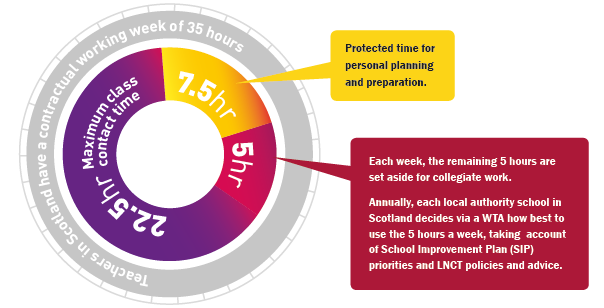One of the key aims of the Stand Up for Quality Education campaign is to reduce teachers’ workload burdens. This guide explains how school WTA’s can be used to help teachers take more control of their own workload.
What is a WTA?
A Working Time Agreement (WTA) is a collective agreement reached annually at the school level between the teachers’ trade union(s) and the school management that sets out how teachers’ ‘collegiate hours’ are to be undertaken for the following year. A WTA is a mechanism for all grades of school teaching staff to manage workload and achieve the contractual 35-hour week.
Your Local Negotiating Committee for Teachers (LNCT) will have policies and guidance for schools in your local authority on WTAs.
Each year’s WTA is binding on all teaching staff.
Did you know….?
Excessive workload is, “Anything that makes it impossible for teaching staff to complete their duties within the 35-hour week.”
If you only remember one thing about WTAs…
“Never have more than one collective activity per week on a school WTA calendar that requires all teachers in the school / a department to be in school at once”
Where does the time for all this come from?

I’m really busy… why should I be interested in this?
WTAs allow teachers to review their teaching year and make improvements to the planning of their collegiate activities for the following year for activities such as:

Who does the negotiating?
Your Branch should meet, audit the current year’s collegiate activities and agree on objectives before beginning the WTA negotiations. The EIS has produced an audit document to assist this process. The Branch Negotiating Committee will engage with any other teachers’ unions to mirror the LNCT to form a ‘Teachers’ Side’. The Teachers’ Side will be led by the EIS school rep. The Teachers’ Side negotiates with the Management Side, which is usually led by the Headteacher.
I’ve heard that every WTA must have a calendar – why?

The WTA Calendar is part of the agreed WTA, and it sets out the dates and times of all WTA events for the school session. It must be agreed at the same time as the allocation of a maximum of 5 hours a week of collegiate time. It is a joint document and is not owned by the Management Side, nor can it be unilaterally varied.
The Calendar allows teachers and managers to plan workload demands and avoid pressure points such as parent meetings and report deadlines clashing with other school meetings.
The Calendar should be shared with all staff.
FAQs

What about part-time staff?
All WTA requirements for part-time staff are determined on a pro-rata basis. Teachers and managers should reach agreement at the start of each school session about which events will be attended by part time colleagues. N.B Parttime staff can only be obliged to attend work on a day they don’t normally teach if there is a planned parents’ meeting (SNCT Handbook, Part 2: Section 3.9). Try to schedule staff meetings and parents’ nights on different days of the week each time.
Can a WTA be changed once it has been agreed?
Changes can only be made to a WTA or Calendar in-year with the agreement of both the Teachers’ and Management Sides. If something additional goes in, then something must come out.
What if either side can’t reach an agreement?
Failure to agree on the WTA and Calendar at the school level should be brought to the attention of the Local Association Secretary who will advise on the local processes for handling a ‘Failure to Agree’ a WTA. Collective grievances could also be considered where schools are failing to address workload concerns and such failures should also be reported to the Local Association Secretary for raising at the LNCT. Keeping the previous year’s WTA and Calendar in place is not an acceptable outcome as it frustrates members in improving their working conditions.
Should we be having a staff or departmental meeting every week?
No. There are only 5 hours of collegiate activities per week. Meetings should be planned and balanced alongside other collegiate priorities across the year.
Want to find out more?
Contact your Local Association for information and details of any forthcoming EIS WTA training www.eis.org.uk/contacts/localassociation
